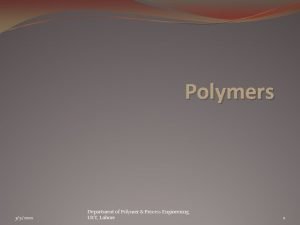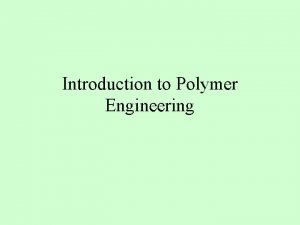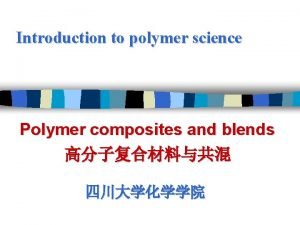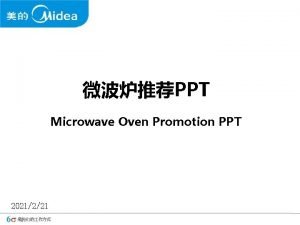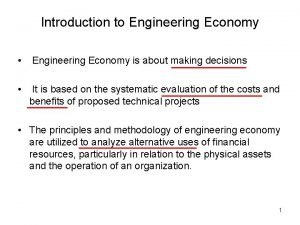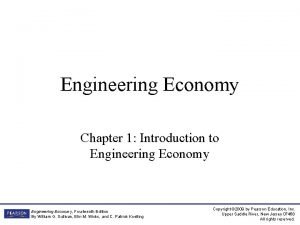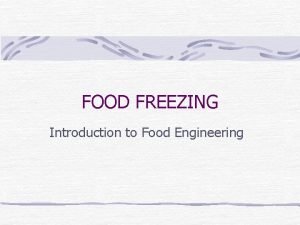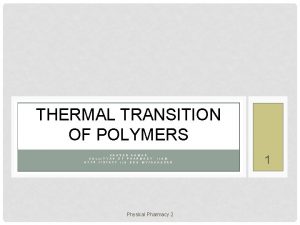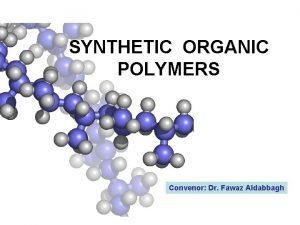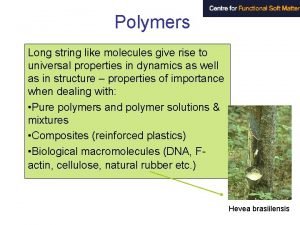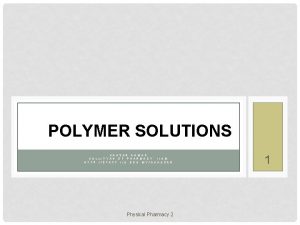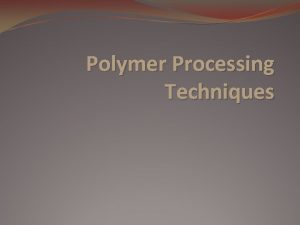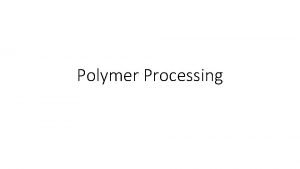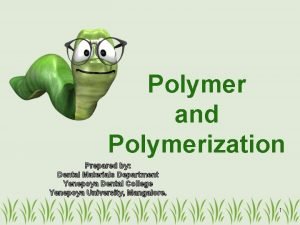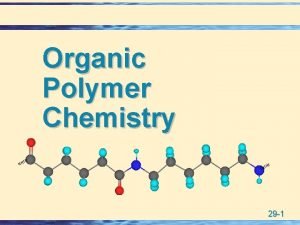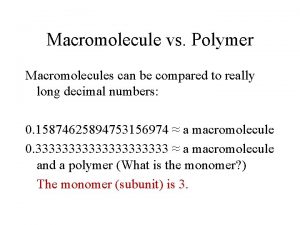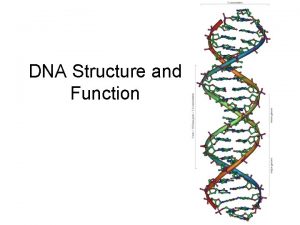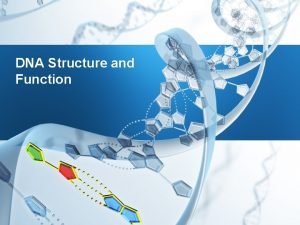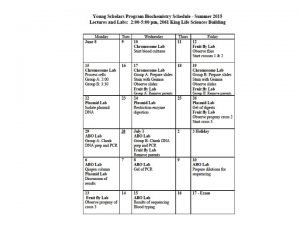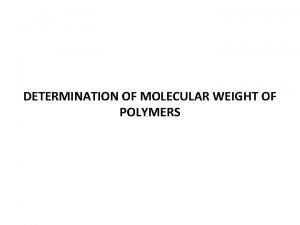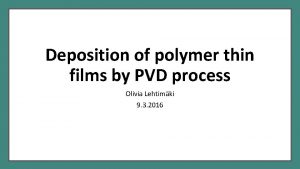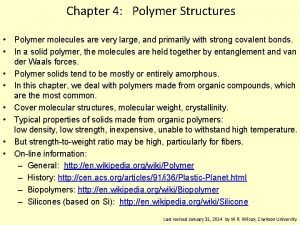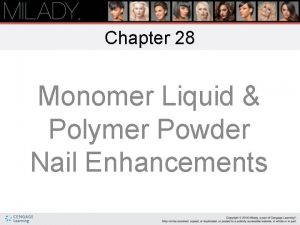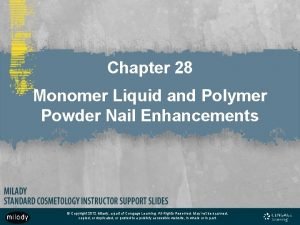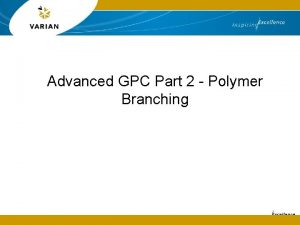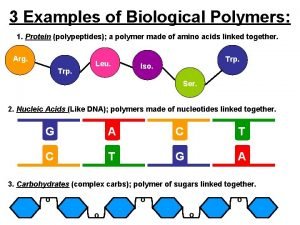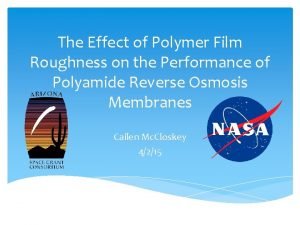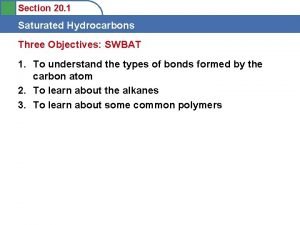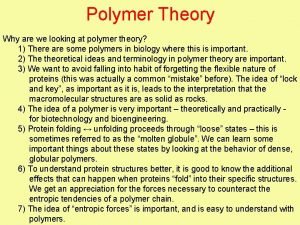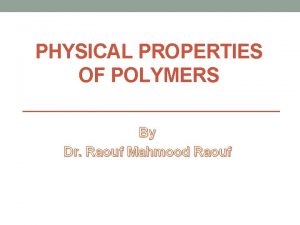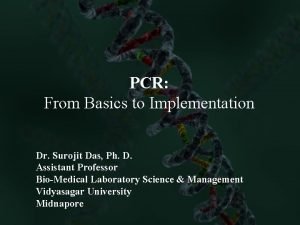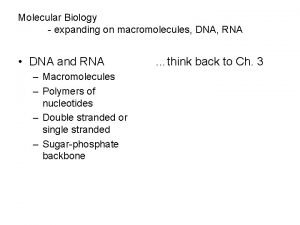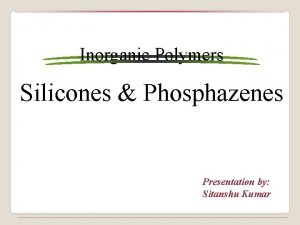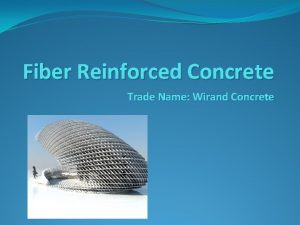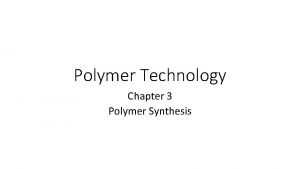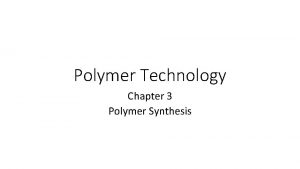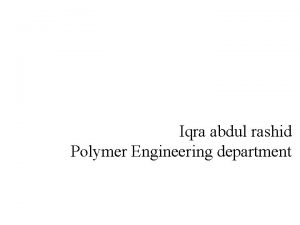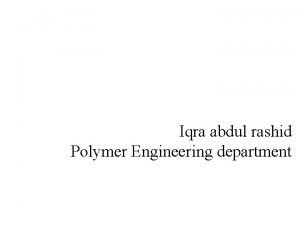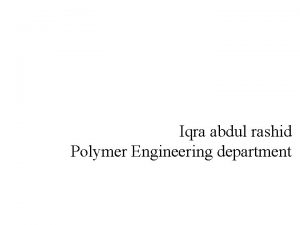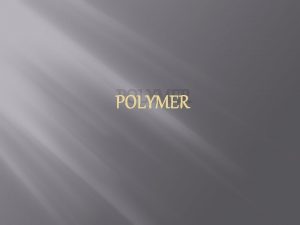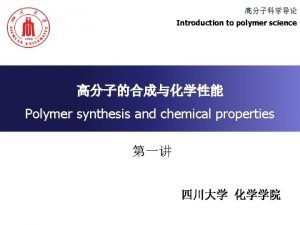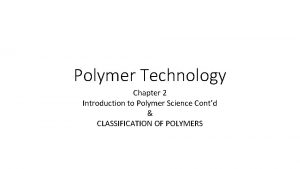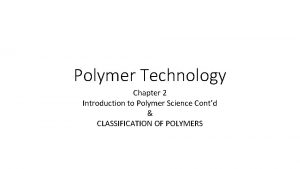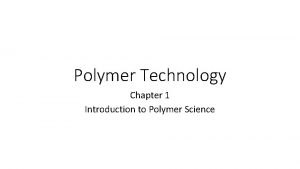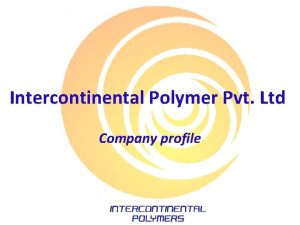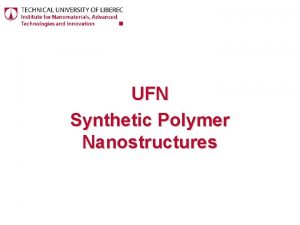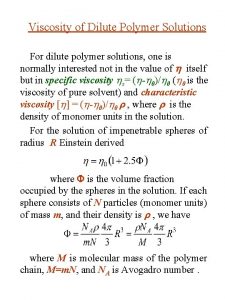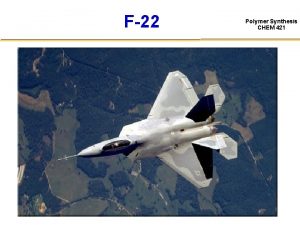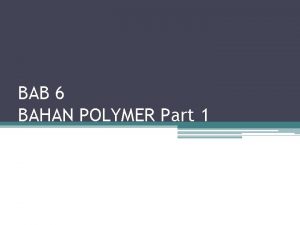Introduction to Polymer Engineering What is polymer A























![(ref: Young and Lovell, Chapman & Hall [1991]) (ref: Young and Lovell, Chapman & Hall [1991])](https://slidetodoc.com/presentation_image_h/2fb2d2fee850157e7cdde6ef0d91edda/image-24.jpg)





































- Slides: 61

Introduction to Polymer Engineering

What is polymer? A molecule of high Mw, structure of which comprises of multiple repetition of units derived from molecules of low relative Mw (monomers)

chemistry: polymer structure connected by covalent bond kinetic: produced from chemical reaction of small units, called “monomer” property: - high strength, with Tg and rubber elasticity, - high viscosity in melt or solution states

History of Polymer

Origin of (Synthetic) Polymers - Petrochemical Industry

Major applications of polymers 1. 2. 3. 4. 5. Plastics Rubbers (or elastomers) Fibers Surface finishes and protective coatings Adhesives -some other applications 6. composites 7. Ion – exchanges resin

1. Plastic

6 Most Commonly-Used Recyclable Plastics Symbols for Properties of Plastics Gas Barrier Gas Permeable Moisture Barrier Chemical resist. Grease&Oil resist. Heat resistance Clarity Ease of forming Heat Insulation Hard Flexible, Ductile Toughness

Polyethylene Terephthalate (PET or PETE) -Strength/toughness, stiffness, resistance to heat -Transparency: Containers for water, -Grease&Oil resistance: vegetable oil -Gas barrier property: Container for soda, carbonated drinks

Polyethylene Terephthalate (PET or PETE) Uses: -- (major) soft drink bottles, mouthwash bottles, food blow-molded containers -- (minor) sheet applications -- (minor) injection molded components ex. bicycle mud guards. -- (minor) spinning fiber for carpet yarns, fiberfill, and geotextiles. Recycled Products: Tote bags, dishwashing liquid containers, clamshells, laser toner cartridges, picnic tables, hiking boots, mailbox posts, fencing, furniture, sweatshirts.

High Density Polyethylene (HDPE) -Relatively straight chain structure, higher density than LDPE -Look milky white -Stiffness, strength/toughness, low cost, ease of forming -Resistance to chemicals -Permeability to gas -Ease of processing

High Density Polyethylene (HDPE) • Uses: wide application in blow molded bottles for milk, water and fruit juices, grocery bags, toys, liquid detergent bottles. (Copolymer HDPE, pigmented with a variety of colorants, is used for packaging toiletries, detergents and similar products. ) • Recycled Products: Recycling bins, benches, bird feeders, retractable pens, clipboards, fly swatters, dog houses, vitamin bottles, floor tile, liquid laundry detergent containers.

Polyvinyl Chloride or PVC) - Broadly divided into rigid and flexible materials. -Versatility, ease of blending -Strength/toughness -Resistance to grease/oil and chemicals -Clarity, Electrical Insulation - Fire retardant

Polyvinyl Chloride or PVC) • Uses – Rigid PVC: 60 percent of total PVC (pipe and fittings, siding, carpet backing, windows, bottles and packaging sheet) – Flexible PVC: (wire and cable insulation, film and sheet, floor coverings, synthetic-leather products, coatings, blood bags, medical tubing etc. ) • Recycled Products: Air bubble cushioning, flying discs, decking, film, paneling, recycling containers, roadway gutters, snowplow deflectors, playground equipment.

Low Density Polyethylene (LDPE) -Ease of processing, ease of sealing, low cost -Barrier to moisture, but air can pass through -Good electrical insulation - Strength/toughness, flexibility, - Low Tg can be used with frozen food

Low Density Polyethylene (LDPE) • Uses: film for plastic retail bags and grocery bags, some flexible lids, wire and cable applications Ex. Bread bags, frozen food bags, grocery bags. • Recycled Products: Shipping envelopes, garbage can liners, floor tile, furniture, film, compost bins, paneling, trash cans, landscape timber, mud flaps.

Polypropylene (PP) - Strength/toughness - Excellent resistance to chemicals - Resistance to heat, resistance to grease/oil, Barrier to moisture - Low cost, versatility, ease of processing, - Lowest density of the plastics used in packaging, high melting point

Polypropylene (PP) • Uses: flexible and rigid packaging, fibers and large molded parts for automotive and consumer products ex. ketchup bottles, yogurt containers and margarine tubs, medicine bottles. • Recycled Products: Signal lights, battery cables, brooms and brushes, ice scrapers, oil funnels, landscape borders, bicycle racks.

Polystyrene (PS) • very versatile, ease of processing, very cheap, • clarity, hard and brittle • poor barrier to oxygen and water vapor • has relatively low melting point (not resistant to heat)

Polystyrene (PS) • Uses: can be rigid or foamed. Typical applications include protective packaging, containers, lids, bottles, trays ex. Video cassette cases, compact disc jackets, coffee cups, knives, spoons and forks, cafeteria trays, grocery store meat trays and fast-food sandwich containers. • Recycled Products: Thermometers, light switch plates, insulation, egg cartons, vents, desk trays, rulers, license plate frames, concrete.

Other recyclable plastics

Examples of 10 most popular polymers

![ref Young and Lovell Chapman Hall 1991 (ref: Young and Lovell, Chapman & Hall [1991])](https://slidetodoc.com/presentation_image_h/2fb2d2fee850157e7cdde6ef0d91edda/image-24.jpg)
(ref: Young and Lovell, Chapman & Hall [1991])

2. Rubbers (or elastomers)

2. Rubbers (or elastomers) 2. 1 Natural rubbers -polymers with Tg < application temp -can be highly stretched (upto 700%) reaction with sulfur vulcanization

2. 2 Polyurethane Form by the reactions of urethane and polyol urethane -CONH- (U) polyol OH----P-----OH (P) -considerably higher tensile strength. -higher tear and abrasion resistance Compare to natural rubber

2. 3 Silicone rubbers Network CH 3 H 2 O Cl-Si-Cl CH 3 O-Si-O CH 3 Pro: -low and high temp stability (-55 to 250 o. C) -elastic even at low temp. -excellent electrical property -extremely inert - กาว (nontacky self adhesive) - bouncing putty

3. Fibers

3. Fibers Cellulose plastics - commonly found in plant’s cell wall - Cotton consists of 90% cellulose, 10% lignin and polysaccharides Structure of cellulose: Has 3 OH-groups in each ring Celluloid –dissolvable in cloroform, acetone etc. - inflammable, poor chemical resistance

O Cellulose Acetate – substituted OH in cellulose with O-C-CH 3 Pro: - water absorptivity O (decrease when OH is replaced by O-C-CH 3 O -หม O-C-CH 3 increase stronger -ใชทำฟลมถายรป (use in photographic film) • Normally, “cellulose” cannot be dissolved in any solvent • “Rayon” is regenerated cellulose (used to produce fibers) • “Nylon” is synthetic polymer (used commonly as fibers)

4. Surface finishes and protective coatings

4. Surface finishes and protective coatings Paints– need the following qualities: -quick drying (แหงเรว ) -cling well to surfaces (ยดเกาะกบพนผว -prevent erosion and corrosion (ปองกนการสกกรอนและการกดกรอน ) ) Types of paints - alkyd and polyester resin - phenolic resin (reaction of phenol+formaldehyde) - Acrylic resin - Polyurethane


5. Adhesives

5. Adhesives • Adhesive (กาว): is in liquid form when applying, then becomes solid and form joint between two surfaces afterwards. • Crosslinking reaction (curing reaction) – To form network polymers (occurs in polymers with more than 2 functional groups) Cured polymer = network high MW polymer (not dissolve in any solvents) Application: adhesive, paints, fiber-reinforced composite, ion-exchanged resin, polymeric reagents Milky-white glue – PVAC (Polyvinyl Acetate) Clear glue – PVOH (Polyvinyl Alcohol)

• 3 types of common adhesives are • Non-reactive • Pressure sensitive • Reactive 1. Non-reactive adhesive: quick-drying solvent containing polymer, tackifier and antioxidant (tackifier = low MW liquid used to enhance surface adhesion of the glue) ex. นำมนสน (pine oil), hydrocarbon derivatives) Several polymers have natural permanent tack no need for tackifier ex. Nat. rubber, silicone rubber, polyvinyl ethyl isobutyl ethers

• กระบวนการ adhesion ของกาว nonreactive wetting on surface solvent evaporates เกด permanent bond btw. surfaces 2. Pressure-sensitive adhesive: กาวแบบ non-reacting )do not lose adhering property even when solvent is already evaporated. This is possible because the polymer used in this case is liquid polymers ex. Silicone rubber (NOTE: silicone polymers has permanent tack & high thermal stability )-75 to 250 C)) 3. Reactive adhesive: ex. Epoxy adhesive –curing reaction occurs at room temp. Liq. material Cured (crosslink) Solid network

Table 2. 3 Some common adhesive

Table 2. 3 Some common adhesive (con’t)

Table 2. 3 Some common adhesive (con’t)

6. Composites

6. Composites • Contain at least 2 phases • To increase mechanical properties ex. strength, toughness, high-temp application • Polymer composite: the continuous phase is polymer. 2 types of reinforcing materials (1) Particle reinforced composite (2) Fiber reinforced composite Examples of reinforcing material: glass, carbon, ceramic, Kevlar (hard polymeric polyaramid)

Glass Fiber Carbon Fiber Mat Chopped Glass Fiber Roll Tail of an RC helicopter, made of Carbon fiber reinforced plastic Glass Fiber Mat http//: en. wikipedia. org/wiki/Carbon_fiber Particles Carbon black Silica Talcum

• Polymer composites – commonly found are: Thermoset : polyester, epoxy resin, polyimides, phenolic resin, rubber Thermoplastic composite: can be found in some application ex. PE, PP Recycling is possible, strength is not as good as thermoset Glass (Si. O 2) : - used as filler - compatibility w/ polymer is enhanced by treated w/ r-amino propyl ethoxy silane to form organic coating OH Glass OH Si NH 2

POLYMER COMPOSITE 1. CONVENTIONAL COMPOSITE 2. NANOCOMPOSITE j Intercalated Nanocomposite j Exfoliated Nanocomposite

NANOFILLER : MONTMORILLONITE IS HYDROPHILIC SILICATE

TEM images of ) a (HNBR/MMT–ODA and ) b (HNBR/FHT–ODA nanocomposites )10 phr filler amount. (

7. Ion exchange resin

7. Ion exchange resin - is solid object w/ exchangeable cations or anion or both Cation exchanger Anion exchanger Amphoteric exchanger - Mostly porous solid object with functional group that can exchange ions ex. Zeolite, organic ion exchanger Ion exchange resin: commonly found in water treatment by replacing Na+ on the resin with Ca 2+ from the hard water

• Zeolite – is a rather soft and porous compound of aluminosilicate - synthetic zeolite is sometimes called molecular sieve = • Organic ion exchange : is made of crosslinked polymer gels. - The polymer matrix consists of ions that are cation or anion exchangers O Ex. cation exchange เชน SO 3 -1, CO-1, PO 3 -2, As. O 3 -2 anion exchange เชน NH 4+1, NH 2+, N+ , S+

Organic ion exchanger : Most oftenly found are: coplymer gel of styrene and divinyl benzene (DVB), with ~ 8 -12% DVB Sulfonation was then carried out in conc. sulfuric acid

Two Possible form of ion exchange resins used for water treatment

Approaches to Reduce Plastic Waste

Approaches to Reduce Plastic Waste Synthetic and semi-synthetic polymers were developed for their durability and resistance to all forms of degradation including biodegradation. BEFORE: Plastics landfill waste problems! PRESENT: 2 approaches • Recycling technology (management of plastic waste) – Labor intensive, downgrading performance from virgin plastics • Environmentally degradable plastics (get rid of the non-degradable problem, but expensive!) – Ex. Biobased polymeric material, degradable polymers

History of Environmental Management �� 1960 's: : Dilution is the solution to pollution �� Acceptable until the carrying capacity of the earth is exceeded �� 1970's and 1980's: Treatment of wastes �� Money down the drain ? �� 1990's onwards : Cleaner Production �� Initially, focused on a particular process stream �� Now, system-wide (holistic) or life-cycle approach

Waste Management Hierarchy �� Reduce �� Reuse �� Recycle �� Incinerate with energy recovery �� Incinerate without energy recovery �� Landfill

Recycling is not Impact-free �� Mechanical recycling �� Thermosets : grinding, particulation for reuse �� Thermoplastics : remelting and extrusion / pelletisation �� Chemical recycling �� Materials recycling �� Monomers for new plastics �� Fuels �� Energy

Plastic recycling • Packaging industry 20 -40% of plastic production contributes greatly to the waste. • Technologies based on recycling include: – Mechanical recycling • reprocessed to similar products, or new products of inferior quality—most widespread – Feedstock retrieval • By hydrolysis, pyrolysis obtain basic chemicals – Energy recovery by incineration • By incineration get high energy comparable to fuel precaution: harzadous emission from chemical reactions with polymer additives

Environmentally Degradable Plastics – Good for future sustainable development – Difficult to produce, maybe more expensive

Questions to think about! • How is the desired molecular structure obtained? • How do the polymer’s processing (i. e. formability) properties depend on its molecular structure? • How do its material properties (mechanical, chemical, optical, etc. ) depend on molecular structure? • How do material properties depend on a polymer’s processing history? • How do its applications depend on its material properties? Production (1) Molecular Structure (2) (3) Processing Properties (4) Material Properties (5) Applications
 Polymer process engineering
Polymer process engineering What is polymer engineering
What is polymer engineering Introduction to polymer blends
Introduction to polymer blends System architecture example
System architecture example Forward engineering in software engineering
Forward engineering in software engineering Principles of complex systems for systems engineering
Principles of complex systems for systems engineering Elegant systems
Elegant systems Forward and reverse engineering
Forward and reverse engineering Isometric view and isometric projection
Isometric view and isometric projection Introduction to civil engineering
Introduction to civil engineering Industrial engineering approach
Industrial engineering approach E type software
E type software Microwave oven promotion
Microwave oven promotion Introduction to web engineering
Introduction to web engineering Introduction to engineering economy
Introduction to engineering economy Scope of engineering economics
Scope of engineering economics Introduction to reliability engineering
Introduction to reliability engineering Ptt 444
Ptt 444 Engineering survey definition
Engineering survey definition Introduction to traffic engineering
Introduction to traffic engineering Drafting is also known as drawing
Drafting is also known as drawing Chemical engineering thermodynamics 8th solution chapter 2
Chemical engineering thermodynamics 8th solution chapter 2 Engineering economy problems
Engineering economy problems Indirect contact freezing
Indirect contact freezing Intro to reverse engineering
Intro to reverse engineering Ntcip
Ntcip Introduction to software engineering course outline
Introduction to software engineering course outline Polymer tg and tm
Polymer tg and tm Fawaz aldabbagh
Fawaz aldabbagh Radius of gyration of polymer
Radius of gyration of polymer Radius of gyration
Radius of gyration Characteristics of polymer
Characteristics of polymer Types of polymer processing techniques
Types of polymer processing techniques Classification of extrusion process
Classification of extrusion process Dental monomer and polymer
Dental monomer and polymer What is organic polymer
What is organic polymer Macromolecule vs polymer
Macromolecule vs polymer Weave patterns forensics
Weave patterns forensics Dna polymer and monomer
Dna polymer and monomer Dna features
Dna features Is dna a linear polymer
Is dna a linear polymer Methods for determining molecular weight of polymers
Methods for determining molecular weight of polymers Pvd polymer
Pvd polymer Material science and engineering iit delhi
Material science and engineering iit delhi Chemsheets condensation polymers
Chemsheets condensation polymers Capillary viscometer
Capillary viscometer Polymer repeat unit
Polymer repeat unit Designs inside a nail enhancement
Designs inside a nail enhancement What is the chemistry behind ml/pp and how does it work?
What is the chemistry behind ml/pp and how does it work? Polymer branching analysis
Polymer branching analysis Polymer of protein example
Polymer of protein example Unique polymer aids
Unique polymer aids Surface roughness of polymer film
Surface roughness of polymer film Saturated polymer
Saturated polymer Polymer persistence length
Polymer persistence length Physical properties of polymers ppt
Physical properties of polymers ppt Polymerase chain reaction (pcr) applications
Polymerase chain reaction (pcr) applications Nucleic acid polymer
Nucleic acid polymer Silicones and phosphazenes pdf
Silicones and phosphazenes pdf Partially impregnated and surface coated polymer concrete
Partially impregnated and surface coated polymer concrete Dna meaning
Dna meaning Stress strip nail
Stress strip nail
